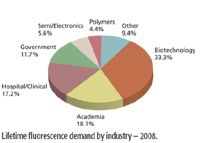Market Profile: Lifetime Fluorescence
Lifetime fluorescence is a subset of fluorescence spectroscopy in which the time between excitation and relaxation is measured, rather than just the intensity of the emitted energy. The technique is used primarily in biological applications, but has a number of other uses as well. Lifetime fluorescence is a well-established niche market.
Lifetime fluorescence is a subset of fluorescence spectroscopy in which the time between excitation and relaxation is measured, rather than just the intensity of the emitted energy. The technique is used primarily in biological applications, but has a number of other uses as well. Lifetime fluorescence is a well-established niche market.

Lifetime fluorescence demand by industry - 2008.
Lifetime fluorescence typically measures the time it takes for molecules to fluoresce after being excited by a light source. Frequency domain lifetime fluorescence compares the modulation and phase-shift of the emitted energy relative to the excitation energy instead. An increasingly popular technique within the lifetime fluorescence market is FLIM, which stands for "Fluorescence Lifetime Imaging," and is very useful for examining biological tissues.
Lifetime fluorescence is by far most popular in biological analyses, which accounts for more than half of demand when considering academia, government, and hospital & clinical applications. There is limited application in areas such as electronics for developing LEDs, characterizing polymers in the plastics industry, and identification and characterization of crude oil in the environmental and oil & gas industries.
The total market for lifetime fluorescence was about $18 million in 2008. Despite the global recession, demand is not likely to contract drastically due to its connection to the healthcare, academic, and government areas. Longer-term annual growth is likely to be in the low single digits.
The foregoing data were based on SDi's market analysis and perspectives report entitled Global Assessment Report, 10th Edition: The Laboratory Life Science and Analytical Instrument Industry, September 2008. For more information, contact Stuart Press, Vice President – Strategic Analysis, Strategic Directions International, Inc., 6242 Westchester Parkway, Suite 100, Los Angeles, CA 90045, (310) 641-4982, fax: (310) 641-8851, www.strategic-directions.com.

New Study Reveals Insights into Phenol’s Behavior in Ice
April 16th 2025A new study published in Spectrochimica Acta Part A by Dominik Heger and colleagues at Masaryk University reveals that phenol's photophysical properties change significantly when frozen, potentially enabling its breakdown by sunlight in icy environments.
Tracking Molecular Transport in Chromatographic Particles with Single-Molecule Fluorescence Imaging
May 18th 2012An interview with Justin Cooper, winner of a 2011 FACSS Innovation Award. Part of a new podcast series presented in collaboration with the Federation of Analytical Chemistry and Spectroscopy Societies (FACSS), in connection with SciX 2012 ? the Great Scientific Exchange, the North American conference (39th Annual) of FACSS.
Can Fluorescence Spectroscopy Evaluate Soil Dissolved Organic Matter Dynamics?
February 20th 2025A new study published in Chemical Engineering Journal by researchers from Northeast Agricultural University in China reveals that biochar aging, influenced by environmental factors like UV exposure and wet-dry cycles, alters dissolved organic matter composition and affects its effectiveness in remediating cadmium-contaminated soil.
New Fluorescent Raman Technique Enhances Detection of Microplastics in Seawater
November 19th 2024A novel method using fluorescence labeling and differential Raman spectroscopy claims to offer a more efficient, accurate approach to detect microplastics in seawater. Developed by researchers at the Ocean University of China, this method improves both the speed and precision of microplastic identification, addressing a key environmental issue affecting marine ecosystems.